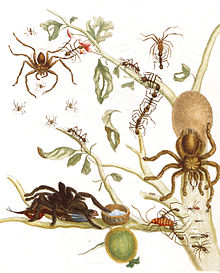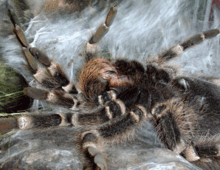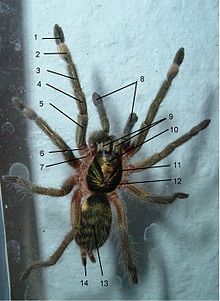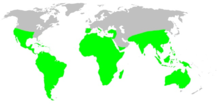Tarantulas
| Tarantulas | ||||||||||||
|---|---|---|---|---|---|---|---|---|---|---|---|---|

Female of Brachypelma smithi |
||||||||||||
| Systematics | ||||||||||||
|
||||||||||||
| Scientific name | ||||||||||||
| Theraphosidae | ||||||||||||
| Thorell , 1869 |
The tarantulas (Theraphosidae) are a family in the suborder of the tarantula-like (Mygalomorphae) within the web spiders (Araneae) and comprise 146 genera and 979 species , which are distributed over 12 subfamilies. (As of December 2018)
Tarantulas appeared in the Carboniferous 350 million years ago. Their habitat are primarily tropical to subtropical climatic zones. Colloquially, the term "tarantulas" is sometimes used to refer to representatives of other species of tarantula.
Origin of the names

They probably owe their common German name "Vogelspinne" to the famous natural scientist and artist Maria Sibylla Merian . She published her impressions from a trip to Surinam in 1705 in the work Metamorphosis insectorum Surinamensium . On page 18 there is an illustration of a large spider sitting on a branch eating a hummingbird. This in turn inspired Carl von Linné in 1758 to describe a spider with the scientific name Aranea avicularia (today: Avicularia avicularia ( Linnaeus , 1758) ).
anatomy

2: midfoot (metatarsus)
3: splint (tibia)
4: knee (patella)
5: thigh (femur)
6: thigh ring (trochanter)
7: hip (coxa)
8: button (pedipalpen) on the lower picture with bulbs
9: biting claws (chelicerae)
10: eyes
11: front body / upper side (prosoma / carapace)
12: deepening of upper side (thoracic pit)
13: abdomen (opisthosoma / abdomen)
14: large pair of spinnerets
15: small pair of spinnerets
16: upper Book lung pair
17: lower book lung pair
18: genital opening (epigastral furrow)
19: underside front body (sternum)
20: mouth opening (labium)
21: male genital organ (globe)
The tarantula is one of the arthropods . Your body is divided into several sections. In the tarantula, a rough distinction is made between the front body ( prosoma ) with the four pairs of legs ( extremities ), the (jaw) palms ( pedipalps ) and the bite claws ( chelicerae ) and the abdomen (opisthosoma) with the spinnerets .
With a body length of up to 12 centimeters and a wingspan of up to 28 centimeters, the species Theraphosa blondi is the largest tarantula in the world described so far.
Front body
The front body (prosoma, 11) of the tarantula consists of the head and chest pieces that have grown together. The top is referred to as the carapace (11) and the bottom as the sternum (19). At the front of the front body are the bite claws (9), the mouth opening (20) and the buttons (8). The four pairs of legs are on the side. The thoracic pit (12) can also be seen on the top. This pit is used in many identification keys to e.g. B. to distinguish the different species of tarantulas. At the end there is the connection ( petiolus ) to the abdomen (13). Inside the front body is the suction stomach. With this, the liquefied food in front of the mouth opening is sucked up.
Walking legs
The four pairs of legs of the tarantula are divided into seven segments:
- Foot ( tarsus , 1)
- Metatarsal ( metatarsus , 2)
- Splint ( tibia , 3)
- Knee ( patella , 4)
- Thigh ( femur , 5)
- Thigh ring ( trochanter , 6)
- Hip ( coxa , 7)
In some genera, e.g. B. Grammostola , Psalmopoeus or Avicularia , the adult males have so-called shin hooks (tibial apophyses) on the first pair of legs on the rail segment. During the mating act, these serve to block the chelicerae (poisonous claws) of the female. But they are not always used.
Button
The buttons (Pedipalpen, 8) are constructed like the walking legs, but they only consist of six segments. These are called the same as for the walking legs, the metatarsus (2) is omitted. In adult males there are bulbs at the probe ends . These are folded in on the living animal. Young animals and females use these buttons like a fifth pair of legs. The adult male drums the buttons to draw attention to himself. When it is ready to mate, the female replies by drumming the buttons. Sometimes the first and second pair of legs are also used, for example in Avicularia .
Chelicerae
The biting claws (chelicerae, 9) are used by the spider to catch prey, while they strike straight down and slightly inward. These biting claws (orthognath), aligned parallel to the longitudinal axis, differentiate the tarantula-like from the real spiders (Araneomorphae).
When catching prey, the biting claws penetrate the victim and the venom is injected through a fine channel . The poison gland is located in the upper part of the bite claws. At the same time, the injected poison is used for digestion, i.e. H. it breaks down the body of the prey animal so that the tarantula can suck it out afterwards.
eyes
The tarantula's eyes (10) are relatively small and sit on the mound of eyes. The sense of sight is only weakly developed in tarantulas. They have primary eyes and secondary eyes. The main eyes perceive images and colors and are useful for packing prey. The secondary eyes, on the other hand, perceive movements.
Abdomen
The abdomen (opisthosoma, 13) is the most sensitive part of the spider, as it is not surrounded by a continuous exoskeleton like the foreleg . Tergites and sternites , which are not fully hardened, are connected by soft-skinned pleura . This allows the abdomen to expand with each meal, so the nutritional status can be recognized by its abundance. However, falls from relatively low heights can be fatal if the abdomen bursts open and the animals bleed to death. Most of the organs of tarantulas are located in the abdomen, including the tubular heart, the sex organs, the two pairs of book lungs (upper = 17, lower = 16) and parts of the intestine.
Some American genera (all genera of the subfamily Theraphosinae) have stinging hairs on the abdomen , for example Brachypelma , Grammostola or Theraphosa , in contrast to Psalmopoeus . These hairs sit loosely on the abdominal skin and are thrown at the troublemaker or enemy when the animal is disturbed by rapid rubbing with the hind legs. Avicularia do not actively strip off the stinging hairs, but stretch the abdomen towards them. The pointed stinging hairs have barbs and can cause severe skin irritation. Specimens of the genus Brachypelma make use of their stinging hairs quite often. In the case of heavily "bombarding" spiders, you can then definitely see the "naked" skin. If this skin turns dark to black, it can be assumed that it is about to shed its skin. The black color comes from the exuvial fluid that separates the old from the new skin.
At the end of the abdomen are the anus and the two pairs of spinnerets. The tarantula has a large (14) and a small pair of spinnerets (15). The finger-shaped spinnerets are divided into three limbs and are each movable individually. The spider produces spider silk with special glands on the spinnerets. The animals use this silk for self-protection, for reproduction or for food intake.
Genital opening
The genital opening (18) is on the underside of the abdomen. It is called the epigastric groove. During the act of mating, the male introduces the ends (bulbs) of his buttons here. If the female builds a cocoon , the eggs are laid out of this opening past the semen storage container ( spermathec ). The eggs are fertilized as they slide past the semen storage container. This container is skinned with every molt, so that every female is "virgin" again after molting.
In the male, the seminal fluid emerges at this opening, which is released onto a previously spun network of sperm. This sperm network is spun between two objects (e.g. terrarium wall / plant). To release the seminal fluid, the male crawls under the net upside down. Then it climbs onto the net and pumping up the liquid with the bulbs. The network is then mostly destroyed.
development
The development of tarantulas takes place in three phases: time in the cocoon (egg and larva), nymph and imago (adult animal).
The cocoon

A carpet of spider silk is spun through the mother animal, whereupon she lays the eggs. The eggs are fertilized inside the body. When mating, the male fills his sperm with his bulbs (21), the last remodeled limb of the feelers ( pedipalps ), into the so-called sperm library of the female. The eggs slip past this sperm library when they are laid and are thus fertilized. After the mother has laid its eggs, the eggs are covered with a layer of spider silk. The female forms the cocoon from the base, the eggs and the upper layer. The cocoon is often wrapped in additional layers of spider silk. The cocoon is guarded by the mother animal.
The time in the egg


After some time, the larvae hatch from the eggs in the cocoon. These larvae do not yet look much like spiders. The term "egg with legs" describes the appearance well. The division into front and rear bodies can be seen. The four pairs of legs and the pair of buttons spread from the front body. The mound of eyes can already be seen. The remains of the egg form the abdomen. After a while in the cocoon, the animals shed their skin to form larva II. The young animals now look very much like a spider. The proportions are almost the same. The biting claws ( chelicerae ) are well developed and recognizable, as are the spinnerets. As larvae, the animals do not accept any food. In some cases, however, it has already been observed that larvae absorbed unfertilized eggs or weaker siblings. The larvae molt into nymphs while they are still in the cocoon. The cocoon is usually only opened by the mother when the larvae have molted into nymphs, but this can also happen earlier. It happens again and again that the cocoon is eaten by the mother during this development phase, because the movements of the nymphs respond to the mother's urge to eat. The freshly skinned nymphs initially stay with the cocoon. The development time depends on the species and the prevailing temperature.
The nymph


In the German-speaking world, the nymph is sometimes referred to as a spiderling. There is also the slang term Fresshaut. The tarantula keeper describes the animals' juvenile developmental stages as feeding skins, in which they eat their own food - according to old textbooks (nymphs). The fully developed nymph is the "first eating skin". With each moult, the number of the scavenger skin (FH) increases, i.e. 1st FH, 2nd FH, 3rd FH, and so on.
Before the spider is sexually mature (adult), it needs a different number of moults depending on the species. The time intervals between moults depend on the climate. The intervals between the moults are four to eight weeks at the beginning. The distance increases with each moult. The number of moults is partly also dependent on gender. The males often grow up earlier.
Depending on the species, the animal is already adult after one year ( Psalmopoeus cambridgei ) or only after seven to ten years ( Mexican red-knee tarantula , Brachypelma smithi ). But here, too, the outside temperatures are decisive. The warmer it is (28–32 ° C), the faster it grows and the animals shed their skin. At lower outside temperatures (20–24 ° C) the development takes longer because of the reduced metabolism of the cold blooded animals. Keeping the animals mentioned above at 24–28 ° C is optimal. The optimal temperature for keeping varies from species to species. Animals from higher altitudes prefer cooler temperatures, those from savannas or desert areas higher.
The adult animal


After moulting, it is spoken of an adult (adult) animal. For the male, this is the last molt of his life, but the females continue to molt - once a year, old animals only every two years. They are still growing in size. The difference in size before and after molting is no longer as great as in nymphs.
An adult male can be easily recognized by his bulbs (21), which in the living animal are folded in towards the body. In many species the males still have shin hooks (tibial apophyses), which are supposed to block the female's bite claws when mating.
In females, the molting is difficult to determine because they have no external signs. You can only be sure when the female has built a cocoon. The semen storage container (spermathec) is already present in female nymphs. With each molt, it is also skinned, so that sex determination is already possible with nymphs. It also grows with your whole life. Exceptions are the species Sickius longibulbi and Encyocratella olivacea , in which the females have no spermathec.
In some species, a distinctly colored sexual dimorphism appears after the moult . This means that there are decisive external differences between males and females.
prey
Tarantulas will eat anything that can overwhelm them. These are usually larger insects such as crickets, cockroaches and grasshoppers . But millipedes and scorpions also belong to the prey spectrum. Large species of tarantulas hunt small lizards and small rodents , rarely small (poisonous) snakes . Nest pups or sick birds can also be overwhelmed. Despite their name, healthy birds are rarely prey for tarantulas.
Tarantula bites
Despite their size, while most tarantulas are painful to bite , they are harmless unless there is an allergic reaction. In many books this is compared to the sting of a bee or wasp, but this is not true in all species. Only in representatives of the Asian genus Poecilotheria and some African species such as Pterinochilus murinus or Stromatopelma calceatum can a bite rarely be accompanied by muscle cramps and drowsiness that can last for several days. Quite often, however, a secondary infection occurs after a bite, triggered by the numerous germs on the spider's chelicerae .
Natural enemies
The natural enemies of tarantulas include wasps , such as Pepsis formosa in America . In some places, centipedes and scorpions are predators. Even small predatory vertebrates, such as the African mongoose , occasionally prey on tarantulas. Wandering ants attack everything that cannot escape during their forays, including spiders of all sizes and types.
Some New World (American) tarantulas have, in addition to their defensive behavior, so-called stinging hairs on their abdomen, which are studded with barbs. These are thrown at potential enemies with rapid movements of the rear pairs of legs (so-called bombing ). They are also a passive protection, as they peel off when touched in order to get caught on the attacker. The stinging hairs in the mucous membranes and eyes can lead to inflammation. Repeated contact with them can also lead to allergic reactions. The hair on the skin causes uncomfortable itching. Some Avicularia species spray fecal fluid at the alleged attacker.
Tarantulas for food
In some areas of South America and Asia tarantulas are prepared as food . In Cambodia , for example, tarantulas are fried and sold as street food .
Systematics and distribution
The system of tarantulas is still in constant flux, as new species are constantly being described, old species are being revised and relationships are being revealed. The description and revision of new species is usually effected classically based morphological examinations on the animals themselves. The relationships of the individual species, genera and subfamilies with each other, by contrast, as with all taxa of extraordinarily diverse order of spiders , now almost exclusively based on molecular genetic studies explored , since the methods of morphology are not sufficient here to be able to make valid statements.
The arachnologist Günter Schmidt differentiates in his standard work "The tarantulas" from 2003 twelve subfamilies. Since then there have been numerous changes to the nomenclature . a. led to the dissolution of a subfamily and also changed the range of species of some subfamilies. The subfamily Spelopelminae Smith listed by Schmidt was dissolved in 2003 in 1995 , since all species of the single genus Spelopelma Gertsch were synonymous with Hemirrhagus Simon , 1903 through a revision in 1982 . The genus Hemirrhagus belongs to the subfamily Theraphosinae .
In 2008 Robert Samm and Günter Schmidt themselves transferred the genera Psalmopoeus and Tapinauchenius from the Aviculariinae into a new subfamily, which was initially named Sinurticantinae Samm & Schmidt , 2008 . However, the new subfamily was renamed Psalmopoeinae Samm & Schmidt , 2010 by the authors in 2010 for nomenclature reasons .
The following list gives an overview of the 12 subfamilies and their distribution:
- Aviculariinae Simon , 1874 - Baja California , Caribbean , Central and South America
- Eumenophorinae Pocock , 1897 - Arabian Peninsula and Africa
- Harpactirinae Pocock , 1897 - Africa
- Ischnocolinae Simon , 1892 - Europe, Africa, Middle East , Arabian Peninsula, India , Caribbean, Central and South America
- Ornithoctoninae Pocock , 1895 - India and Southeast Asia
- Poecilotheriinae Simon , 1892 - India and Sri Lanka
- Psalmopoeinae Samm & Schmidt , 2010 - Caribbean, Central and Northern South America
- Selenocosmiinae Simon , 1889 - India, Sri Lanka, Southeast Asia, and Australia
- Selenogyrinae Smith , 1990 - Africa and Western India
- Stromatopelminae Schmidt , 1993 - Africa
- Theraphosinae Thorell , 1990 - North, Central, and South America
- Thrigmopoeinae Pocock , 1900 - India
A complete listing of all 146 genera and 979 species can be found in the list of tarantula species .
literature
- S. Rafn: tarantulas. Kirschner & Seufer Verlag, Rheinstetten 2007, ISBN 978-3-9808264-9-5 .
- P. Klaas: Tarantulas: Origin, Care, Species. Eugen Ulmer Verlag, Stuttgart, 2003, ISBN 3-8001-3696-1 .
- HW Kothe: tarantulas. Franckh-Kosmos Verlag, Stuttgart 2003, ISBN 3-440-09367-0 .
- G. Schmidt: The tarantulas. Westarp Sciences, Hohenwarsleben, 2003, ISBN 3-7842-0484-8 .
- BF Striffler: The red knee tarantula. Natur und Tier-Verlag, Münster 2004, ISBN 3-937285-10-5 , p. 64.
- V. von Wirth: tarantulas. Gräfe and Unzer Verlag, Munich, 2005, ISBN 3-7742-6821-5 .
- Rainer F. Foelix: Biology of the spiders. 2., revised. u. exp. Edition. Thieme, Stuttgart 1992, ISBN 3-13-575802-8 .
Individual evidence
- ↑ Natural History Museum of the Burgergemeinde Bern: World Spider Catalog Version 19.5 - Theraphosidae . Retrieved December 24, 2018.
- ^ R. Bertani: Release of urticating hairs by Avicularia versicolor (Walckenaer, 1837) (Araneae, Theraphosidae). In: The Bulletin of the British Arachnological Society. 12 (9), 2003, pp. 395-398.
- ^ R. Bertani, CS Fukushima, PIS Júnior: Mating behavior of Sickius longibulbi (Araneae, Theraphosidae, Ischnocolinae), a spider that lacks spermathecae. In: The Journal of Arachnology. 36, 2008, pp. 331-335. (PDF)
- ↑ RC Gallon: A new African arboreal genus and species of theraphosid spider (Araneae, Theraphosidae, Stromatopelminae) which lacks spermathecae. In: The Bulletin of the British Arachnological Society. 12 (9), 2003, pp. 405-411. (PDF)
- ↑ G. Schmidt: The tarantulas. Westarp Sciences, 2003, ISBN 3-89432-899-1 , pp. 101-288.
- ^ F. Pérez-Miles, A. Locht: Revision and cladistic analysis of the genus Hemirrhagus Simon, 1903 (Araneae, Theraphosidae, Theraphosinae). In: Bulletin of the British Arachnological Society. 12, 2003, pp. 365-375.
- ^ R. Samm, G. Schmidt: Sinurticantinae subfamilia nov. - a new subfamily of the Theraphosidae (Araneae). In: Tarantulas of the World. 140, 2008, pp. 3-14.
- ^ R. Samm, G. Schmidt: Psalmopoeinae subfamilia nov. - a new subfamily of the Theraphosidae (Araneae). In: Tarantulas of the World. 142, 2010, pp. 35-41.
Web links
Theraphosidae in the World Spider Catalog
- German Arachnological Society V. (DeArGe) - German association that promotes arachnology and takes care of the transmission of information in this field (publication organ : ARACHNE - ISSN 1613-2688 )
- Tarantula e. V. - German association that wants to expand and deepen arachnology and the general level of knowledge and knowledge exchange in this field.
- British Tarantula Society
- Group d'etude des arachnides (French tarantula association)
- The Dutch Tarantula Society
- www.wissenschaft.de: What spiders and chillies have in common - tarantula venom activates the same receptors as hot paprika




